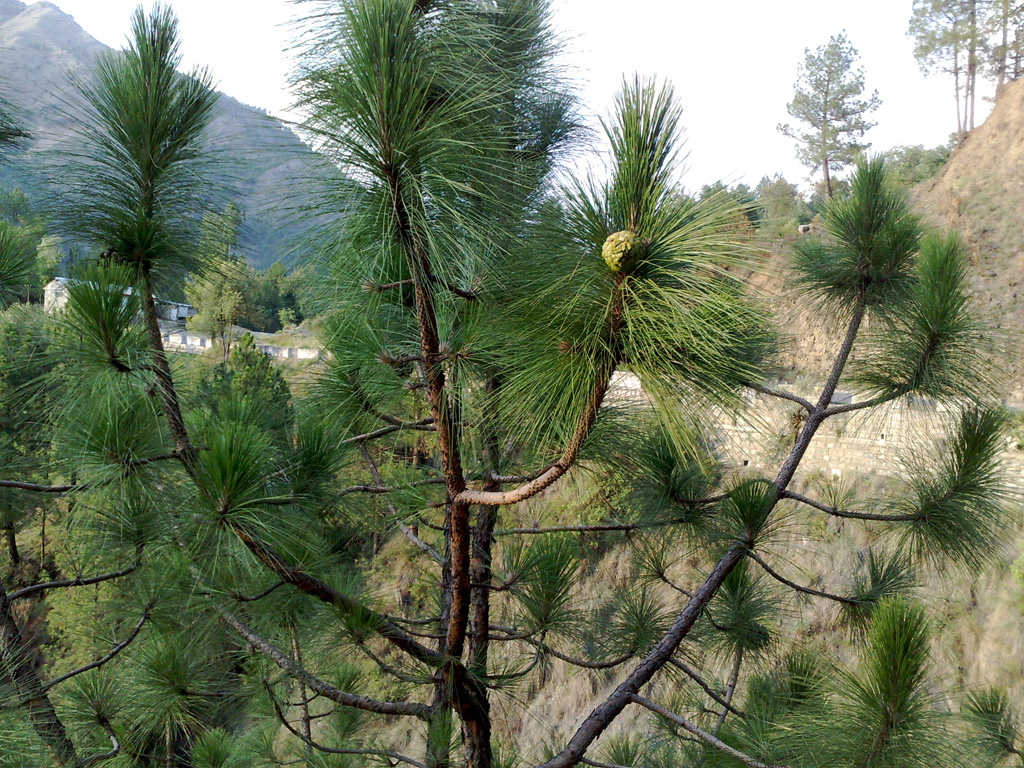Important Facts For Prelims
Pine Needle Power Projects
- 17 May 2024
- 6 min read
Why in News?
Uttarakhand's innovative pine needle power projects, aimed at mitigating forest fires and generating electricity, have fallen short of expectations. Despite the vast potential, technological and practical challenges have hindered their success.
What are Pine Needle Power Projects?
- Pine Needle Power Projects: In 2021, the Uttarakhand State government under bio-energy projects announced a scheme to establish power projects that would use pine needles as fuel to generate electricity.
- The original plan was to establish multiple units ranging from 10kW to 250 kW across the State in three phases (worth about 150 MW).
- Though the government expected 58 units to be set up, only six units of 250 kW (totally worth 750 kW) have been established.
- Agency Involved: Uttarakhand Renewable Energy Development Agency (UREDA).
- Potential of Pine Needles as a Resource: 16.36% of Uttarakhand's forest area is covered by chir pine (Pinus roxburghii) forests. An estimated 15 lakh tonnes of pine needles are generated annually in the state.
- If 40% of this, coupled with agricultural residue, could be utilised, it could significantly aid the state's power requirements and provide employment.
- Ecological Impact: Chir pine as an exotic Species prevents the regeneration of localised species.
- Using pine needles as fuel is more efficient and less polluting than using them as firewood or letting them burn away.
Renewable Energy from Pine Needles
- Pine needles in India's sub-Himalayan belt pose a fire hazard, yet they also offer the opportunity to be converted into renewable energy sources like bio-oil, briquettes, or biochar.
- Bio-oil can be used as fuel for engines or furnace oil, while briquettes can be used in brick kilns or boilers for electricity generation.
- Researchers from India's Central Institute of Agricultural Engineering found that the flammability of pine needles makes them a potentially abundant renewable energy source.
- They can be compacted into high calorific value briquettes or converted into bio-oil through pyrolysis.
- The bio-oil has a calorific value of 28.52 megajoules per kilogram and can be used in blended fuels for engines or as furnace oil. This makes it a viable alternative to diesel.
Why have Pine Needle Projects Been Unsuccessful?
- Technological Limitations: According to UREDA, the appropriate technology to sustainably use pine needles for electricity generation does not labour yet.
- Operational Difficulties: Collecting pine needles is challenging due to the steep forest slopes, vulnerability to animal attacks, and insufficient labour at remunerative rates.
- Additionally, the moisture content of the pine needles causes lower efficiency and high maintenance for the gasification system.
- Only a minuscule proportion of available pine needles is currently being collected.
Key Facts about Chir Pine
- Family Name: Pinaceae | Botanical Name: Pinus roxburghii.
- Geographic Origin: India | Ecozone Origin: Indomalaya.
- Natural History: It is one of the most important conifers in the Himalayan region which moulds the life of various ethnic and other communities of the region.
- It is named after William Roxburgh, a Scottish botanist known as the founding father of Indian botany.
- Vegetation Type: The Chir Pine is well-adapted to the Montane Temperate Forests of the Himalayas.
- The dense canopy of Chir Pine trees limits the growth of other plants underneath. However, some shrub species like Rubus ellipticus, Fragaria vesca, Myrica esculenta, etc can survive in these pine forests.
- Geographical Extent: Distributed across the Himalayan mountains, including Bhutan, India (J&K, Punjab, Himachal Pradesh, Uttarakhand), Nepal, Pakistan, Sikkim, Afghanistan, and southern Tibet.
- Characteristics:
- Coniferous tree-producing pine cones with gymnosperm (naked seeds).
- Dark-brown, thick deeply longitudinal fissured bark.
- Leaves grouped three per bundle, slender, flexible, flabellate-triangular in cross-section.
- Growing Conditions:
- Hardy, drought and high-temperature resistant.
- Requires full sun exposure.
- Young trees need weekly watering; mature trees need monthly watering.
- Suitable Locations: Better suited for spacious areas due to its massive root system.
- IUCN Red List Status: Least Concern
UPSC Civil Services Examination, Previous Year Questions (PYQs)
Prelims:
Q. If you travel through the Himalayas, you are likely to see which of the following plants naturally growing there? (2014)
- Oak
- Rhododendron
- Sandalwood
Select the correct answer using the code given below:
(a) 1 and 2 only
(b) 3 only
(c) 1 and 3 only
(d) 1, 2 and 3
Ans: (a)





